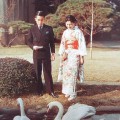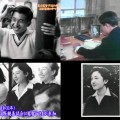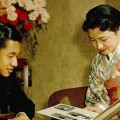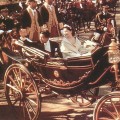Fifty Years Ago: Imperial Happy Ending
In 1957, twenty-three-year-old Crown Prince Akihito of Japan felt sad and pessimistic. For nearly six years now, the Imperial Household Agency (IHA) had been busy to find him a bride – and prospects were bad. After putting together a list of 860 eligible candidates, young ladies descendant from families of the Japanese former nobility, the IHA had set to work and checked their past and pedigree. But up until now, the officials had either found fault with the ladies’ background, the crown prince had not liked them or – something very close to being a scandal and certainly something that, before the war, had been absolutely unheard of – their families had politely let the court know that they felt very much honoured indeed, but were still not interested. Thanks, but no, thanks.
The problem was not in Akihito’s person: he was the first heir to the Japanese throne to ever have graduated from a university, he was a keen sportsman and talented musician. He had been sent in June 1953 to represent the Japanese court at the coronation of the English queen and had acquitted himself to everybody’s satisfaction. But, unfortunately, not every Japanese family nowadays wanted their daughter to become crown princess and vanish in a gilded cage. It was the prince’s position that rendered him so unattractive. And Prince Akihito was getting to be so depressed by the situation that he was considering to renounce his claim to the throne.
But then, in August 1957, in Karuizawa, an exclusive and expensive resort in the Japanese alps, the prince happened to play a doubles tennis game, his partner being Kenji Ishizuka, a student of Waseda University. And, to their very great surprise, the two young men lost the match 6-4, 5-7, 1-6 – against a thirteen-year-old French boy and a student of English literature at Tokyo’s Sacred Heart Women’s university: Michiko Shoda. Miss Shoda, it has to be admitted, did not meet any of the two criteria the IHA had originally set up for a crown princess candidate: she was neither being educated at Gakushuin University (attended by the offspring of Japan’s former nobility), nor could she offer aristocratic ancestry (although she came from a very wealthy and respectable commoner family). But the prince was immediately smitten and very much impressed by her energy: “I hit the ball and hit it again, but she would always hit it back. No matter what sort of ball she gets she never gives up and tries to hit it back to me. I have lost against her persistence.”
When Akihito met the young lady again in autumn of the same year on a tennis court in Tokyo, he took a photo of her. He had it framed and sent it to Miss Shoda. The portrait was also shown to the admiring public in a photo gallery. And, in February 1958, the prince asked his counselor Shinzo Koizumi to have Michiko Shoda put on the list of crown princess candidates. The IHA carefully checked the family background of the young lady, and, in August 1958, they gave their approval. Shinzo Koizumi went to the Shoda family to make the marriage offer.
But, alas, the family was not at all pleased to hear their visitor’s message but, to the contrary, rather shocked. The Shodas remembered well the times before the war when the tenno had been worshipped like a god. They could see no way for their commoner daughter to ever be accepted by the old elite. (And, it has to be said here: they, sadly, turned out to have been absolutely right in their fears…) Accordingly, without hesitation, the Shoda family sent their daughter on a two-months world trip. This could easily be interpreted as a distinct, final “no” to the royal proposal.
But for young Michiko, things were obviously not that clear. Her letters to her family formulated her doubts concerning the crown prince’s offer – but they also showed that, wherever she went, she could hardly stop thinking about the issue: “I ought not to accept the marriage offer as long as I am still feeling, if even only a little bit, that I am making a sacrifice. I must not make my partner happy by my sacrifice. Instead, I have to be convinced that I can become sufficiently happy myself by this marriage. If I do not feel that, I will neither be able to make the prince happy.”
Michiko’s mother showed this letter to Akihito’s counselor Koizumi. But against her expectations, he was not disappointed by the young lady’s cool reflections but, on the other hand, impressed by her good sense. He borrowed the letter from Mrs Shoda and showed it to the infatuated prince who, hardly surprisingly, sighed again: “There is really no woman for me other than Michiko.” He even confessed to a friend that, if Michiko would not consent to marry him, he wanted to kill himself.
But although Akihito was madly in love, he, too, had not failed to consider if Michiko would be able to make a good crown princess. Sure, if a former chamberlain of the prince declares that, at their first meeting, Akihito was moved by Michiko’s “quiet patience and modest behaviour”, this would rather have to be qualified as “traditionalist wishful thinking.” (You do not win a hard tennis match against two healthy young men by “quiet patience” and with “modest behaviour.”) But there seems to be much sense in what a former aristocrat, Mototsugu Akashi, says: “Michiko impressed the prince by her strong will. He was convinced that Michiko would be sufficiently strong and persistent to carry the burden and the responsibility of the monarchy.”
Accordingly, as soon as charming Miss Shoda was back in Tokyo, the prince went on the attack. With the help of his friend Kazuo Oda, he organized daily telephone calls to the Shoda house. That was a rather complicated enterprise as his mother was strictly opposing the connection, and Michiko’s parents were also to be kept in the dark, at least as long as possible. Finally, on November 8, 1958, Michiko accepted his offer: “I have already spent my dowry on my trip abroad. So, if you would be willing to take me with only a suitcase.”
According to a close friend of Akihito, Akira Hashimoto, Michiko overcame her doubts, at last, because the prince’s loneliness moved her. She said: “When I hear from him about how much he wanted a family, and had to live his life without a family, I begin to cry. When he told me that ‘I must not die before I have my own family’, never in my life have I heard such heart-breaking words, not even in a novel.”
The imperial marriage on 10 April, 1959, triggered an economic boom in Japan as many people decided to buy their first television sets to watch what was to most Japanese commoners like the coming true of a fairy tale and what symbolized a radical break with the recent past that had been marked by the horrors of war and defeat. (Believe it or not: Even the emperor and the empress – who, according to tradition, could not attend the wedding in person – watched the event on television.) The new commoner crown princess created the so-called “Michi Boom”, a period characterized by wildly enthusiastic popular interest in the throne. The first yellow press periodicals came into existence to satisfy the public’s curiosity. (Two of them, Shukan Josei and Josei Jishin, exist to this day.) Journalist Oya called the time between engagement and wedding of the “modern couple” Akihito and Michiko “the greatest demonstration of the imperial family after the war.” The prediction of Prince Akihito’s quaker teacher seemed to come true: with this beautiful, bright young bride at his side, the crown prince was really the “hope of new Japan.”
Watch a video of Michiko and Akihito courting and raising their children!
Filed under JapanTagged Biography, Emperor Akihito of Japan, Empress Michiko of Japan, Wedding Anniversary.











Leave a Reply